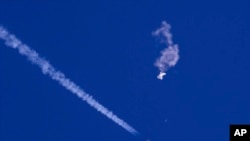Canadian Prime Minister Justin Trudeau said Saturday that on his order a U.S. fighter jet shot down an "unidentified object" that was flying high over Canada’s Yukon Territory, acting a day after the U.S. took similar action over Alaska.
North American Aerospace Defense Command, the combined U.S.-Canada organization that provides shared defense of airspace over the two nations, detected the object flying at a high altitude Friday evening over Alaska, U.S. officials said.
Two F-22 aircraft from Joint Base Elmendorf-Richardson, Alaska, monitored the object over U.S. airspace with the assistance of Alaska Air National Guard refueling aircraft, tracking it closely and taking time to characterize the nature of the object, according to a statement from Pentagon Press Secretary, Brigadier General Pet Ryder.
The object crossed into Canadian airspace on Saturday.
The U.S. and Canada continued to monitor the object in Canadian airspace, with Canadian CF-18 and CP-140 aircraft joining the formation to further assess the object, Ryder’s statement said.
Trudeau spoke with President Joe Biden, who also ordered the object to be shot down. Canadian and U.S. jets operating as part of NORAD were scrambled, and it was a U.S. jet that shot down the object using an AIM 9X missile.
Later Saturday night in the U.S., the Federal Aviation Administration closed some Montana airspace.
The FAA confirmed to VOA News that airspace over Montana was closed to civilian aircraft for several hours on Saturday evening “to support Department of Defense activities.” Montana Congressman Matt Rosendale said an object was spotted and “the DOD will resume efforts to observe and ground the object in the morning.”
The airspace was later reopened, an FAA spokesman said.
U.S. F-22 fighter jets have now taken down three objects in the airspace above the U.S. and Canada over seven days, a stunning development that is raising questions about what is hovering overhead and who has sent them.
At least one of the objects downed was believed to be a spy balloon from China, but the other two have not yet been publicly identified. While Trudeau described the object Saturday as "unidentified," a NORAD spokesman, Major Olivier Gallant, said the military had determined what it was but would not reveal details.
Trudeau said Canadian forces would recover the wreckage for study. The Yukon is westernmost Canadian territory and the among the least populated part of Canada.
Just about a day earlier, White House National Security Council spokesman John Kirby said an object roughly the size of a small car was shot out of the skies above remote Alaska. Officials couldn't say if it contained any surveillance equipment, where it came from, or what purpose it had.
Kirby said it was shot down because it was flying at an altitude of about 13,000 meters and posed a "reasonable threat" to the safety of civilian flights, not because of any knowledge that it was engaged in surveillance.
According to U.S. Northern Command, recovery operations continued Saturday on sea ice near Deadhorse, Alaska.
In a statement, the Northern Command said there were no new details on what the object was. It said the Alaska Command and the Alaska National Guard, along with the FBI and local law enforcement, were conducting search and recovery.
"Arctic weather conditions, including wind chill, snow, and limited daylight, are a factor in this operation, and personnel will adjust recovery operations to maintain safety," the statement said.
On February 4, U.S. officials shot down a large white balloon off the coast of South Carolina.
The Pentagon has said the balloon was part of a large surveillance program that China has been conducting for "several years." The U.S. has said Chinese balloons have flown over dozens of countries across five continents in recent years, and it learned more about the balloon program after closely monitoring the one shot down near South Carolina.
China responded that it reserved the right to "take further actions" and criticized the U.S. for "an obvious overreaction and a serious violation of international practice."
The Navy continued survey and recovery activities on the ocean floor off South Carolina, and the U.S. Coast Guard was providing security. Additional debris was pulled out Friday, and additional operations will continue as weather permits, Northern Command said.









